Kentucky Pest News Newsletter
HIGHLIGHTS IN THIS ISSUE
Number 1066__________July 25, 2005
WATCH FOR
TOBACCO
CORN
SOYBEAN
FRUIT
SHADE TREES AND ORNAMENTALS
DIAGNOSTIC LAB HIGHLIGHTS
IPM TRAP COUNTS

WATCH FOR
WATCH FOR:
By Lee Townsend
- FLEAS on pets
- GREEN JUNE BEETLES on over-ripe fruits and corn silks
- BLISTER BEETLES on vegetable crops.


TOBACCO
BLUE MOLD AND THE RECENT HEAT WAVE
By Kenny Seebold
 Several cases of blue mold were reported across KY during the week of July 18. Actively sporulating blue mold was found in the following counties: Breckinridge, Daviess, Fayette, and Harrison. Fortunately, weather conditions have not been favorable for widespread movement of spores and disease development, and are likely to remain this way for several weeks. The North American Plant Disease Forecasting Center is predicting relatively low risk for production areas not situated in the immediate vicinity of known sources of blue mold.
Several cases of blue mold were reported across KY during the week of July 18. Actively sporulating blue mold was found in the following counties: Breckinridge, Daviess, Fayette, and Harrison. Fortunately, weather conditions have not been favorable for widespread movement of spores and disease development, and are likely to remain this way for several weeks. The North American Plant Disease Forecasting Center is predicting relatively low risk for production areas not situated in the immediate vicinity of known sources of blue mold.
Even though the current hot spell will reduce the risk for blue mold development, our growers should scout their fields regularly for signs and symptoms of blue mold. If cooler, rainy weather sets in, we could see rapid spread of the disease across the Commonwealth.
STINK BUG INJURY ACCENTUATED BY HOT WEATHER
By Lee Townsend
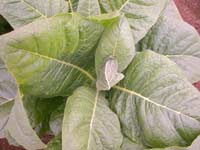 Sudden collapse of a single upper leaf, or even the entire bud area of a tobacco plant, can be the
result of a stink bug "bite" caused when these insects their sucking mouthparts into a leaf midrib
or the upper stalk. In a leaf bite, the affected tissue collapses then, turns very dark green.
Under cool, cloudy conditions, the leaf will re-expand and be relatively normal. However, under the
very hot, sunny conditions we have been seeing, the affected leaf will scald. This causes a yellow
area that eventually turns brown and disintegrates. A bite to the upper stalk causes a general
collapse of the bud area and may kill it.
Sudden collapse of a single upper leaf, or even the entire bud area of a tobacco plant, can be the
result of a stink bug "bite" caused when these insects their sucking mouthparts into a leaf midrib
or the upper stalk. In a leaf bite, the affected tissue collapses then, turns very dark green.
Under cool, cloudy conditions, the leaf will re-expand and be relatively normal. However, under the
very hot, sunny conditions we have been seeing, the affected leaf will scald. This causes a yellow
area that eventually turns brown and disintegrates. A bite to the upper stalk causes a general
collapse of the bud area and may kill it.
The brown stink bug seems to be the cause of most of this injury. The winged adults may feed on a few
plants as they move in search of a good host plant. The damage is often greatest in border rows and
becomes less noticeable as you move across a field. Also, the plant reaction is localized so tissue
damage is minimal. Stink bugs do not seem to remain in tobacco fields very long and usually are long
gone by the time we notice any symptoms in the field. Consequently, there is seldom a reason to
apply an insecticide. If 10% to 20% of the plants are showing stink bug damage and the insects are
present in the field, an application of Orthene may be worthwhile. Endosulfan (Thiodan, Golden Leaf
Tobacco Spray, or Phaser) or Warrior are options but check the harvest interval on the label before
using them.
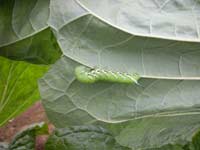 Tobacco and tomato hornworms are relatively common on tobacco now. Be sure to check the infestation
level as you watch the crop; an average of 5 or more hornworms per 50 plants is enough to justify
control.
Tobacco and tomato hornworms are relatively common on tobacco now. Be sure to check the infestation
level as you watch the crop; an average of 5 or more hornworms per 50 plants is enough to justify
control.
For the latest blue mold status and other tobacco disease information, check the KY Blue Mold Warning System online.
 http://www.uky.edu/Agriculture/kpn/kyblue/kyblue.htm
http://www.uky.edu/Agriculture/kpn/kyblue/kyblue.htm

For more information about tobacco pests, visit
"Insect Management Recommendations".

CORN
SECOND GENERATION CORN BORERS ACTIVE
By Ric Bessin
 Now is the time to begin evaluating corn fields for late-season European and southwestern corn
borer activity. This has been a low to moderate year for both corn borer species in the western
part of the state, and moderate numbers of European corn borers were noted in the parts of
central Kentucky. Fortunately many fields have escaped economic losses because of the early
planting dates. These late season larvae will be more of a problem on later-planted, non-Bt corn
and will feed primarily in the ear zone of the plant and below, but may be found in leaf axils over
the entire plant. Leaf axils, leaf sheaths, and ear shanks should be examined for live larvae or
signs of damage. Ear shank tunneling or stalk tunneling below the ear may lead to increased
harvest losses this fall. Severity of the infestations will vary from field to field on a farm, so
fields should be scouted individually. Identification of heavily-infested fields and their early
harvest (where possible) may be an effective strategy to reduce harvest losses due to broken or
lodged plants and ear drop.
Now is the time to begin evaluating corn fields for late-season European and southwestern corn
borer activity. This has been a low to moderate year for both corn borer species in the western
part of the state, and moderate numbers of European corn borers were noted in the parts of
central Kentucky. Fortunately many fields have escaped economic losses because of the early
planting dates. These late season larvae will be more of a problem on later-planted, non-Bt corn
and will feed primarily in the ear zone of the plant and below, but may be found in leaf axils over
the entire plant. Leaf axils, leaf sheaths, and ear shanks should be examined for live larvae or
signs of damage. Ear shank tunneling or stalk tunneling below the ear may lead to increased
harvest losses this fall. Severity of the infestations will vary from field to field on a farm, so
fields should be scouted individually. Identification of heavily-infested fields and their early
harvest (where possible) may be an effective strategy to reduce harvest losses due to broken or
lodged plants and ear drop.
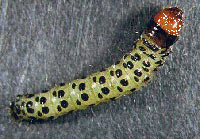 In September, southwestern corn borer larvae that will overwinter travel to the base of the stalk,
make a chamber in the stalk below ground, then girdle the base of the stalk. For this reason,
fields that are heavily infested with southwestern corn borer should be identified and harvested as
early as appropriate.
In September, southwestern corn borer larvae that will overwinter travel to the base of the stalk,
make a chamber in the stalk below ground, then girdle the base of the stalk. For this reason,
fields that are heavily infested with southwestern corn borer should be identified and harvested as
early as appropriate.
For information about corn pests, visit
"Insect Management Recommendations".


SOYBEAN
WHERE ARE THE SOYBEAN APHIDS? CAN YOU SAY HEAT!
By Doug Johnson
 Over the last week or so I have had a number of producers ask "Where are the soybean aphids?" or remark "I can find a few of them but not many". Actually, this has been the case in Kentucky since the soybean aphid was first spotted in 2000. We always have the beast but usually in very small numbers.
Over the last week or so I have had a number of producers ask "Where are the soybean aphids?" or remark "I can find a few of them but not many". Actually, this has been the case in Kentucky since the soybean aphid was first spotted in 2000. We always have the beast but usually in very small numbers.
I think there are two different things at work to keep our populations down. First, the aphid must migrate to Kentucky from the more northern states. No doubt that has already happened because we have found enough aphids to know that they are around. Second, and perhaps more importantly; is the excessive heat.
The soybean aphid appears to be better adapted to cooler temperatures. With temperatures hitting the high 90's during the day and staying way up into the 70's in the evening, perhaps the populations are not able to increase at a very great rate.
In general, I think our full season, early planted beans are going to escape any aphid populations that might occur. Again, this is historically the case in KY. However, do NOT be lulled into the idea that nothing further can happen.
KY producers still have many double-crop fields in the mid-V stages. We will have fields in the early R stages for a very long time. So, we still have fields at risk. Any field that has not moved into the R6 stage will be at risk all through the months of August and most of September. If temperatures moderate, aphid populations can be expected to increase in size.
Things are going good now, but it is not over. If you have fields that are still at risk for Soybean Rust, then they are also at risk for soybean aphid. While you are scouting for rust be sure to look for soybean aphid as well.
For more information about soybean pests, visit
"Insect Management Recommendations".


FRUIT
CUCUMBER BEETLE MANAGEMENT, MID- AND LATE-SEASON
By Ric Bessin
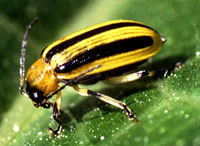 For the most part, most growers have very effective spotted and stripped cucumber beetle
management programs early in the season. This is extremely important not only because of the
direct damage they cause to the developing seedlings, but also as they are the vectors for cucurbit
bacterial wilt. The earlier that plants become infected with this bacteria, the greater the potential
yield loss. Growers have used systemic and/or foliar sprays effectively to control these beetle
pests early in the summer.
For the most part, most growers have very effective spotted and stripped cucumber beetle
management programs early in the season. This is extremely important not only because of the
direct damage they cause to the developing seedlings, but also as they are the vectors for cucurbit
bacterial wilt. The earlier that plants become infected with this bacteria, the greater the potential
yield loss. Growers have used systemic and/or foliar sprays effectively to control these beetle
pests early in the summer.
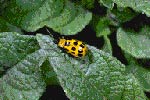 However, as fields get closer to harvest, I've seen many situations where monitoring has been
relaxed and cucumber beetles have caused significant rind damage to cucumber, melon,
watermelon, and pumpkin fruit. Both the spotted and stripped cucumber beetles feed on the
developing fruit. They often feed on the underside of the fruit near where it rests on the soil or
plastic. While the feeding is superficial, it renders the fruit less marketable. This damage is
caused not by the overwintering generation that was active when the plants were small, but by the
first generation that fed on the roots as larvae.
However, as fields get closer to harvest, I've seen many situations where monitoring has been
relaxed and cucumber beetles have caused significant rind damage to cucumber, melon,
watermelon, and pumpkin fruit. Both the spotted and stripped cucumber beetles feed on the
developing fruit. They often feed on the underside of the fruit near where it rests on the soil or
plastic. While the feeding is superficial, it renders the fruit less marketable. This damage is
caused not by the overwintering generation that was active when the plants were small, but by the
first generation that fed on the roots as larvae.
Control of these late season cucumber beetles is a bit more difficult for a couple of reasons. First,
they are much better protected by the plants from foliar sprays. It is more difficult to get the
sprays to the undersides of leaves and fruit when the crop is mature. Higher pressure, volume,
and additional nozzles may be needed to get the needed coverage. Additionally, insecticide
selection is more restrictive due to days to harvest. Growers need to carefully select insecticides
for cucumber beetle control based on the anticipated harvest date and the required waiting period
between application and harvest.


SHADE TREES AND ORNAMENTALS
LANDSCAPE ORNAMENTALS AFFECTED BY ASTER YELLOWS DISEASE
By John Hartman
Herbaceous perennials were observed recently in the plant disease diagnostic laboratory with the striking and unusual symptoms of aster yellows disease. The cause of aster yellows is a plant phloem-inhabiting microscopic bacterium-like organism called a phytoplasma. Aster yellows is vectored (transmitted) by leafhopper insects, and through grafting.
Symptoms. Infected plants are typically stunted, twisted, and produce a proliferation of spindly, secondary shoots or flower stalks, giving the plant a bushy appearance. Foliage may be abnormally yellow or red while floral parts that are normally brightly colored may remain green. Flower petals and sepals may become puckered and distorted and seeds or fruit fail to develop. Infected purple coneflowers, for example, may produce clusters of secondary flower heads which emerge from the primary flower head. In marigolds, flowers are often irregular, deformed, leafy and a muddy green-orange color. Specific symptoms vary from plant to plant. Aster yellows symptoms are more severe and appear more quickly during warm weather while at lower temperatures, plants may be infected without symptom expression. Aster yellows is rarely lethal. Symptoms of aster yellows are often mistaken for damage resulting from herbicide exposure.
Aster yellows biology. Aster yellows is a chronic, systemic disease and can be found on a wide range of broad-leaved, herbaceous plants. The phytoplasma survives winter in perennials and biennials so infected perennials can serve as a source of the aster yellows phytoplasma for many years. In the spring, leafhoppers feed on infected plants and acquire plant sap containing the phytoplasma and the microbe multiplies inside the leafhopper. The phytoplasma is transferred to healthy plants during subsequent leafhopper feeding.
Hosts of aster yellows. Members of the aster family (Asteraceae), such as asters, marigolds, coreopsis and coneflower are some of the most commonly affected plants. Other susceptible flowers include chrysanthemum, cockscomb, cosmos, daisy, dianthus, gladiolus, petunia, and phlox. Susceptible vegetables include carrots, onions, potatoes, and tomatoes. Weeds such as dandelions, plantain, and thistle are also susceptible and can serve as a source of inoculum in home gardens.
Disease management. Once a plant is infected it cannot be cured. Promptly destroy and discard plants suspected of having aster yellows disease to prevent further spread. Remove weeds which may serve as reservoirs for the pathogen and monitor plants for leafhoppers. Insecticides are generally not recommended for the control of leafhoppers in the home garden. If aster yellows disease is persistent over the years, try planting species that are not susceptible. Herbaceous plants such as geraniums, impatiens, and salvia, as well as most woody ornamentals, are not susceptible to aster yellows.


DIAGNOSTIC LAB HIGHLIGHTS
DIAGNOSTIC LAB - HIGHLIGHTS
By Julie Beale and Paul Bachi
During the past week, we have diagnosed potato leaf hopper burn and Lepto leaf spot on alfalfa; downy mildew, thrips injury, potassium deficiency, soybean cyst nematode, anthracnose and Phytophthora root/stem rot on soybean; black shank, blue mold, potassium deficiency, tomato spotted wilt virus, tobacco ringspot virus, black root rot and frogeye leaf spot on tobacco.
On fruit and vegetable samples, we have diagnosed Phytophthora crown rot and anthracnose on grape; fire blight and cedar-apple rust on apple; powdery mildew on pecan; Cercospora leaf spot on bean; anthracnose on gourd; bacterial spot on pepper; early blight, Septoria leaf spot, cucumber mosaic virus, blossom end rot, and Fusarium root/crown rot on tomato.
On ornamentals and turf, we have seen thrips injury, bacterial leaf spot and Pythium root rot on chrysanthemum; Rhizosphaera needlecast on spruce; powdery mildew on tuliptree; stress symptoms and transplant shock on numerous woody plant species; and brown patch on fescue.


IPM TRAP COUNTS:
By Patty Lucas, University of Kentucky Research Center
UKREC-Princeton, KY, July 15-22, 2005
| True Armyworm
| 0
|
| Corn Earworm
| 9
|
| European Corn Borer
| 2
|
| Southwestern Corn Borer
| 122
|
| Fall Armyworm
| 3
|
|
View Princeton trap counts for the entire 2005 season at -
http://www.uky.edu/Ag/IPMPrinceton/Counts/2005trapsfp.htm
Fulton County trap counts are available at -http://ces.ca.uky.edu/fulton/anr/Insect%20Counts.htm
For information on trap counts in southern Illinois visit the Hines Report at -
http://www.ipm.uiuc.edu/pubs/hines_report/comments.html
The Hines Report is posted weekly by Ron Hines, Senior Research Specialist, at the
University of Illinois Dixon Springs Agricultural Center.
NOTE: Trade names are used to simplify the information presented in
this newsletter. No endorsement by the Cooperative Extension Service
is intended, nor is criticism implied of similar products that are not
named.
Lee Townsend
Extension Entomologist
BACK
TO KY PEST NEWS HOME
 Several cases of blue mold were reported across KY during the week of July 18. Actively sporulating blue mold was found in the following counties: Breckinridge, Daviess, Fayette, and Harrison. Fortunately, weather conditions have not been favorable for widespread movement of spores and disease development, and are likely to remain this way for several weeks. The North American Plant Disease Forecasting Center is predicting relatively low risk for production areas not situated in the immediate vicinity of known sources of blue mold.
Several cases of blue mold were reported across KY during the week of July 18. Actively sporulating blue mold was found in the following counties: Breckinridge, Daviess, Fayette, and Harrison. Fortunately, weather conditions have not been favorable for widespread movement of spores and disease development, and are likely to remain this way for several weeks. The North American Plant Disease Forecasting Center is predicting relatively low risk for production areas not situated in the immediate vicinity of known sources of blue mold.



 Sudden collapse of a single upper leaf, or even the entire bud area of a tobacco plant, can be the
result of a stink bug "bite" caused when these insects their sucking mouthparts into a leaf midrib
or the upper stalk. In a leaf bite, the affected tissue collapses then, turns very dark green.
Under cool, cloudy conditions, the leaf will re-expand and be relatively normal. However, under the
very hot, sunny conditions we have been seeing, the affected leaf will scald. This causes a yellow
area that eventually turns brown and disintegrates. A bite to the upper stalk causes a general
collapse of the bud area and may kill it.
Sudden collapse of a single upper leaf, or even the entire bud area of a tobacco plant, can be the
result of a stink bug "bite" caused when these insects their sucking mouthparts into a leaf midrib
or the upper stalk. In a leaf bite, the affected tissue collapses then, turns very dark green.
Under cool, cloudy conditions, the leaf will re-expand and be relatively normal. However, under the
very hot, sunny conditions we have been seeing, the affected leaf will scald. This causes a yellow
area that eventually turns brown and disintegrates. A bite to the upper stalk causes a general
collapse of the bud area and may kill it.
 Tobacco and tomato hornworms are relatively common on tobacco now. Be sure to check the infestation
level as you watch the crop; an average of 5 or more hornworms per 50 plants is enough to justify
control.
Tobacco and tomato hornworms are relatively common on tobacco now. Be sure to check the infestation
level as you watch the crop; an average of 5 or more hornworms per 50 plants is enough to justify
control.

 Now is the time to begin evaluating corn fields for late-season European and southwestern corn
borer activity. This has been a low to moderate year for both corn borer species in the western
part of the state, and moderate numbers of European corn borers were noted in the parts of
central Kentucky. Fortunately many fields have escaped economic losses because of the early
planting dates. These late season larvae will be more of a problem on later-planted, non-Bt corn
and will feed primarily in the ear zone of the plant and below, but may be found in leaf axils over
the entire plant. Leaf axils, leaf sheaths, and ear shanks should be examined for live larvae or
signs of damage. Ear shank tunneling or stalk tunneling below the ear may lead to increased
harvest losses this fall. Severity of the infestations will vary from field to field on a farm, so
fields should be scouted individually. Identification of heavily-infested fields and their early
harvest (where possible) may be an effective strategy to reduce harvest losses due to broken or
lodged plants and ear drop.
Now is the time to begin evaluating corn fields for late-season European and southwestern corn
borer activity. This has been a low to moderate year for both corn borer species in the western
part of the state, and moderate numbers of European corn borers were noted in the parts of
central Kentucky. Fortunately many fields have escaped economic losses because of the early
planting dates. These late season larvae will be more of a problem on later-planted, non-Bt corn
and will feed primarily in the ear zone of the plant and below, but may be found in leaf axils over
the entire plant. Leaf axils, leaf sheaths, and ear shanks should be examined for live larvae or
signs of damage. Ear shank tunneling or stalk tunneling below the ear may lead to increased
harvest losses this fall. Severity of the infestations will vary from field to field on a farm, so
fields should be scouted individually. Identification of heavily-infested fields and their early
harvest (where possible) may be an effective strategy to reduce harvest losses due to broken or
lodged plants and ear drop.
 In September, southwestern corn borer larvae that will overwinter travel to the base of the stalk,
make a chamber in the stalk below ground, then girdle the base of the stalk. For this reason,
fields that are heavily infested with southwestern corn borer should be identified and harvested as
early as appropriate.
In September, southwestern corn borer larvae that will overwinter travel to the base of the stalk,
make a chamber in the stalk below ground, then girdle the base of the stalk. For this reason,
fields that are heavily infested with southwestern corn borer should be identified and harvested as
early as appropriate.


 For the most part, most growers have very effective spotted and stripped cucumber beetle
management programs early in the season. This is extremely important not only because of the
direct damage they cause to the developing seedlings, but also as they are the vectors for cucurbit
bacterial wilt. The earlier that plants become infected with this bacteria, the greater the potential
yield loss. Growers have used systemic and/or foliar sprays effectively to control these beetle
pests early in the summer.
For the most part, most growers have very effective spotted and stripped cucumber beetle
management programs early in the season. This is extremely important not only because of the
direct damage they cause to the developing seedlings, but also as they are the vectors for cucurbit
bacterial wilt. The earlier that plants become infected with this bacteria, the greater the potential
yield loss. Growers have used systemic and/or foliar sprays effectively to control these beetle
pests early in the summer.
 However, as fields get closer to harvest, I've seen many situations where monitoring has been
relaxed and cucumber beetles have caused significant rind damage to cucumber, melon,
watermelon, and pumpkin fruit. Both the spotted and stripped cucumber beetles feed on the
developing fruit. They often feed on the underside of the fruit near where it rests on the soil or
plastic. While the feeding is superficial, it renders the fruit less marketable. This damage is
caused not by the overwintering generation that was active when the plants were small, but by the
first generation that fed on the roots as larvae.
However, as fields get closer to harvest, I've seen many situations where monitoring has been
relaxed and cucumber beetles have caused significant rind damage to cucumber, melon,
watermelon, and pumpkin fruit. Both the spotted and stripped cucumber beetles feed on the
developing fruit. They often feed on the underside of the fruit near where it rests on the soil or
plastic. While the feeding is superficial, it renders the fruit less marketable. This damage is
caused not by the overwintering generation that was active when the plants were small, but by the
first generation that fed on the roots as larvae.


